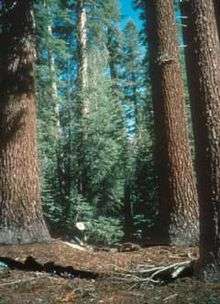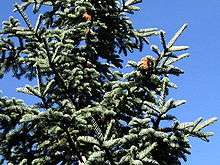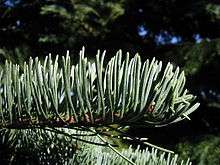Abies magnifica
Abies magnifica, the red fir or silvertip fir, is a western North American fir, native to the mountains of southwest Oregon and California in the United States. It is a high elevation tree, typically occurring at 1,400–2,700 metres (4,600–8,900 ft) elevation, though only rarely reaching tree line. The name red fir derives from the bark color of old trees.
| Abies magnifica | |
|---|---|
 | |
| Red fir forest, Yosemite National Park | |
| Scientific classification | |
| Kingdom: | Plantae |
| Clade: | Tracheophytes |
| Division: | Pinophyta |
| Class: | Pinopsida |
| Order: | Pinales |
| Family: | Pinaceae |
| Genus: | Abies |
| Section: | Abies sect. Nobilis |
| Species: | A. magnifica |
| Binomial name | |
| Abies magnifica | |
 | |
| Natural range of Abies magnifica | |
Description
Abies magnifica is a large evergreen tree typically up to 40–60 metres (130–200 ft) tall and 2 metres (6.6 ft) trunk diameter, rarely to 76.5 metres (251 ft) tall and 3 metres (9.8 ft) diameter, with a narrow conic crown. The bark on young trees is smooth, grey, and with resin blisters, becoming orange-red, rough and fissured on old trees. The leaves are needle-like, 2–3.5 cm long, glaucous blue-green above and below with strong stomatal bands, and an acute tip. They are arranged spirally on the shoot, but twisted slightly s-shaped to be upcurved above the shoot.
The cones are erect, 9–21 cm long, yellow-green (occasionally purple), ripening brown and disintegrating to release the winged seeds in fall.
 Abies magnifica: Cones stand upright on branches |
 Abies magnifica: Needle-like leaves bend upward |
Varieties
There are two, perhaps three varieties:
- Abies magnifica var. magnifica, red fir — cones large (14–21 cm), cone bract scales short, not visible on the closed cones. Most of the species' range, primarily in the Sierra Nevada.
- Abies magnifica var. shastensis, Shasta red fir — cones large (14–21 cm), cone bract scales longer, visible on the closed cone. The northwest of the species' range, in southwest Oregon and Shasta, Siskiyou and Trinity Counties in northwest California.
- A. magnifica on the eastern slopes of southern Sierra Nevada — possibly a third variety, have not been formally named, also having long bracts, and additionally have smaller cones, 9–15 cm long.
Related
Red fir is very closely related to noble fir (Abies procera), which replaces it further north in the Cascade Range. They are best distinguished by the leaves; noble fir leaves have a groove along the midrib on the upper side, while red fir does not show this. Red fir also tends to have the leaves less closely packed, with the shoot bark visible between the leaves, whereas the shoot is largely hidden in noble fir. Some botanists treat Abies magnifica var. shastensis as a natural hybrid between red fir and noble fir.
First recording
This tree was first recorded by William Lobb on his expedition to California of 1849 – 1853, having been overlooked previously by David Douglas.[2]
Uses
The wood is used for general structural purposes and paper manufacture. It is also a popular Christmas tree.
See also
References
- Farjon, A. (2013). "Abies magnifica". IUCN Red List of Threatened Species. 2013: e.T42290A2970154. doi:10.2305/IUCN.UK.2013-1.RLTS.T42290A2970154.en.
- Toby Musgrave; Chris Gardner & Will Musgrave (1999). The Plant Hunters. Seven Dials. p. 147. ISBN 1-84188-001-9.
Further reading
- Chase, J. Smeaton (1911). Cone-bearing Trees of the California Mountains. Chicago: A. C. McClurg & Co. pp. 99. LCCN 11004975. OCLC 3477527. LCC QK495.C75 C4, with illustrations by Carl Eytel - Kurut, Gary F. (2009), "Carl Eytel: Southern California Desert Artist", California State Library Foundation, Bulletin No. 95, pp. 17-20 retrieved Nov. 13, 2011
External links
| Wikimedia Commons has media related to Abies magnifica (red fir). |
